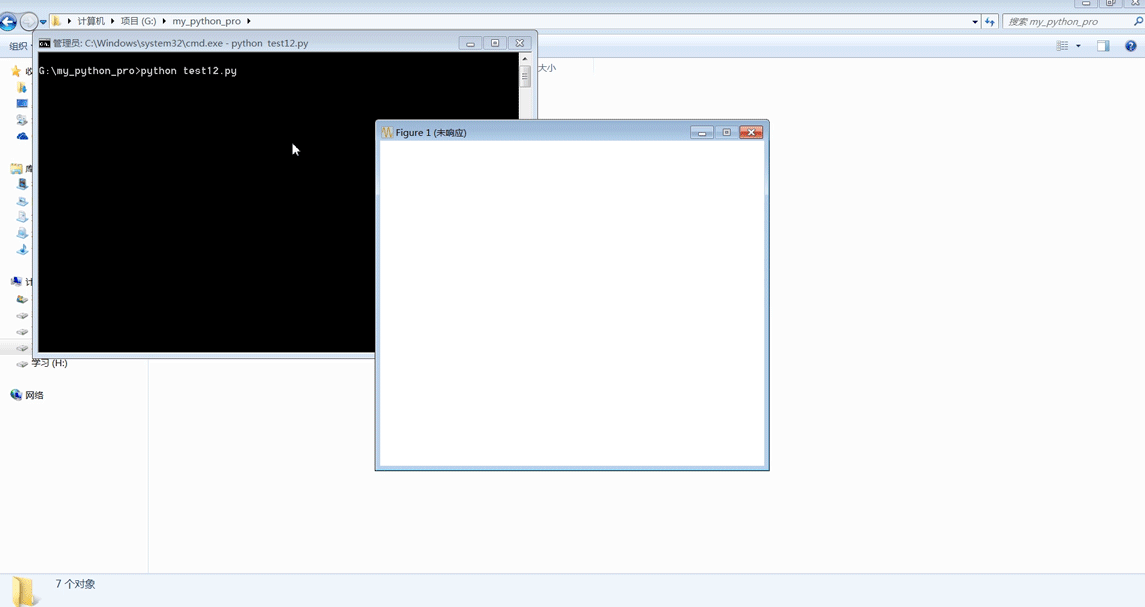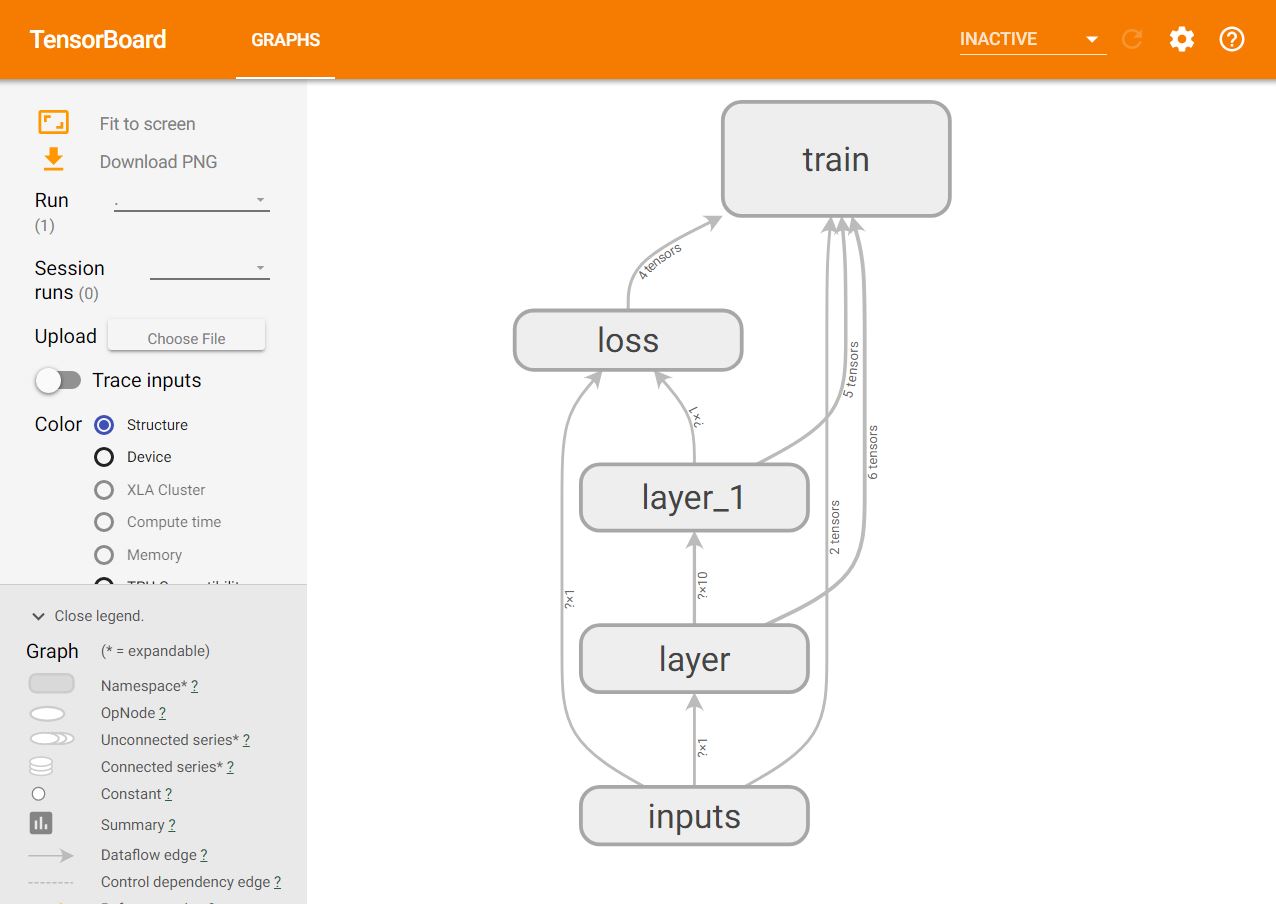在实现上一个例子的基础上,进行了网络的可视化。
也就是利用tensorboard进行操作。这期间我遇到了一些问题,我以前的TensorFlow版本是0.12的,现在我给他升级了。
我用的方法计较简单,先去卸载旧版本,然后下载了1.3.0的whl文件然后去该目录下pip安装。
pip uninstall tensorflow
在浏览器里输入
https://storage.googleapis.com/tensorflow/windows/cpu/tensorflow-1.3.0rc0-cp35-cp35m-win_amd64.whl即可下载对应的版本
pip install https://storage.googleapis.com/tensorflow/windows/cpu/tensorflow-1.3.0rc0-cp35-cp35m-win_amd64.whl安装完成。
运行程序:
import tensorflow as tf
def add_layer(inputs, in_size, out_size, activation_function=None):
# add one more layer and return the output of this layer
with tf.name_scope('layer'):
with tf.name_scope('weights'):
Weights = tf.Variable(tf.random_normal([in_size, out_size]), name='W')
with tf.name_scope('biases'):
biases = tf.Variable(tf.zeros([1, out_size]) + 0.1, name='b')
with tf.name_scope('Wx_plus_b'):
Wx_plus_b = tf.add(tf.matmul(inputs, Weights), biases)
if activation_function is None:
outputs = Wx_plus_b
else:
outputs = activation_function(Wx_plus_b, )
return outputs
# define placeholder for inputs to network
with tf.name_scope('inputs'):
xs = tf.placeholder(tf.float32, [None, 1], name='x_input')
ys = tf.placeholder(tf.float32, [None, 1], name='y_input')
# add hidden layer
l1 = add_layer(xs, 1, 10, activation_function=tf.nn.relu)
# add output layer
prediction = add_layer(l1, 10, 1, activation_function=None)
# the error between prediciton and real data
with tf.name_scope('loss'):
loss = tf.reduce_mean(tf.reduce_sum(tf.square(ys - prediction),
reduction_indices=[1]))
with tf.name_scope('train'):
train_step = tf.train.GradientDescentOptimizer(0.1).minimize(loss)
sess = tf.Session()
writer = tf.train.SummaryWriter("logs/", sess.graph)
# important step
sess.run(tf.initialize_all_variables())这里面有两个问题:
1.tf.initialize_all_variables()已经变成tf.global_variables_initializer()
2.tf.train.SummaryWriter()已经变成了tf.summary.FileWriter()
这俩都是小问题
改完以后注意Writer的写入路径,最好改成根目录,代码如下:
import tensorflow as tf
def add_layer(inputs, in_size, out_size, activation_function=None):
# add one more layer and return the output of this layer
with tf.name_scope('layer'):
with tf.name_scope('weights'):
Weights = tf.Variable(tf.random_normal([in_size, out_size]), name='W')
with tf.name_scope('biases'):
biases = tf.Variable(tf.zeros([1, out_size]) + 0.1, name='b')
with tf.name_scope('Wx_plus_b'):
Wx_plus_b = tf.add(tf.matmul(inputs, Weights), biases)
if activation_function is None:
outputs = Wx_plus_b
else:
outputs = activation_function(Wx_plus_b, )
return outputs
# define placeholder for inputs to network
with tf.name_scope('inputs'):
xs = tf.placeholder(tf.float32, [None, 1], name='x_input')
ys = tf.placeholder(tf.float32, [None, 1], name='y_input')
# add hidden layer
l1 = add_layer(xs, 1, 10, activation_function=tf.nn.relu)
# add output layer
prediction = add_layer(l1, 10, 1, activation_function=None)
# the error between prediciton and real data
with tf.name_scope('loss'):
loss = tf.reduce_mean(tf.reduce_sum(tf.square(ys - prediction),
reduction_indices=[1]))
with tf.name_scope('train'):
train_step = tf.train.GradientDescentOptimizer(0.1).minimize(loss)
sess = tf.Session()
writer = tf.summary.FileWriter("G://my_python_pro", sess.graph)
# important step
sess.run(tf.global_variables_initializer())运行(注意我的路径是G://my_python_pro)然后输入:
tensorboard --logdir=G://my_python_pro如果不知道自己的ip可以直接 cmd→ipconfig
获取ipv4地址
然后在浏览器里输入你的ip地址比如我的是
http://202.118.13.193在后面加上:6006,完整的输入是:
http://202.118.13.193:6006就出来了。























 1151
1151











 被折叠的 条评论
为什么被折叠?
被折叠的 条评论
为什么被折叠?








